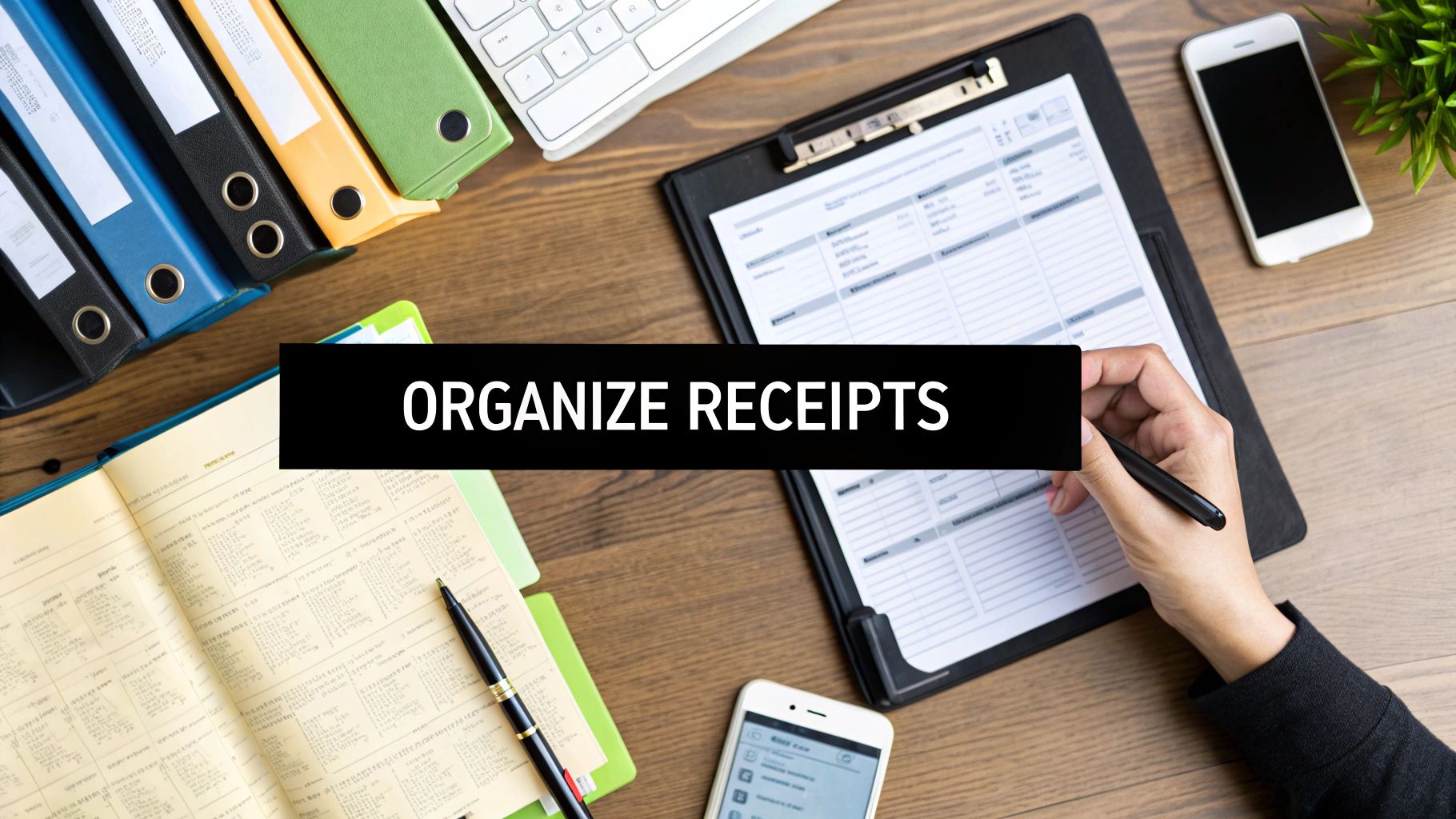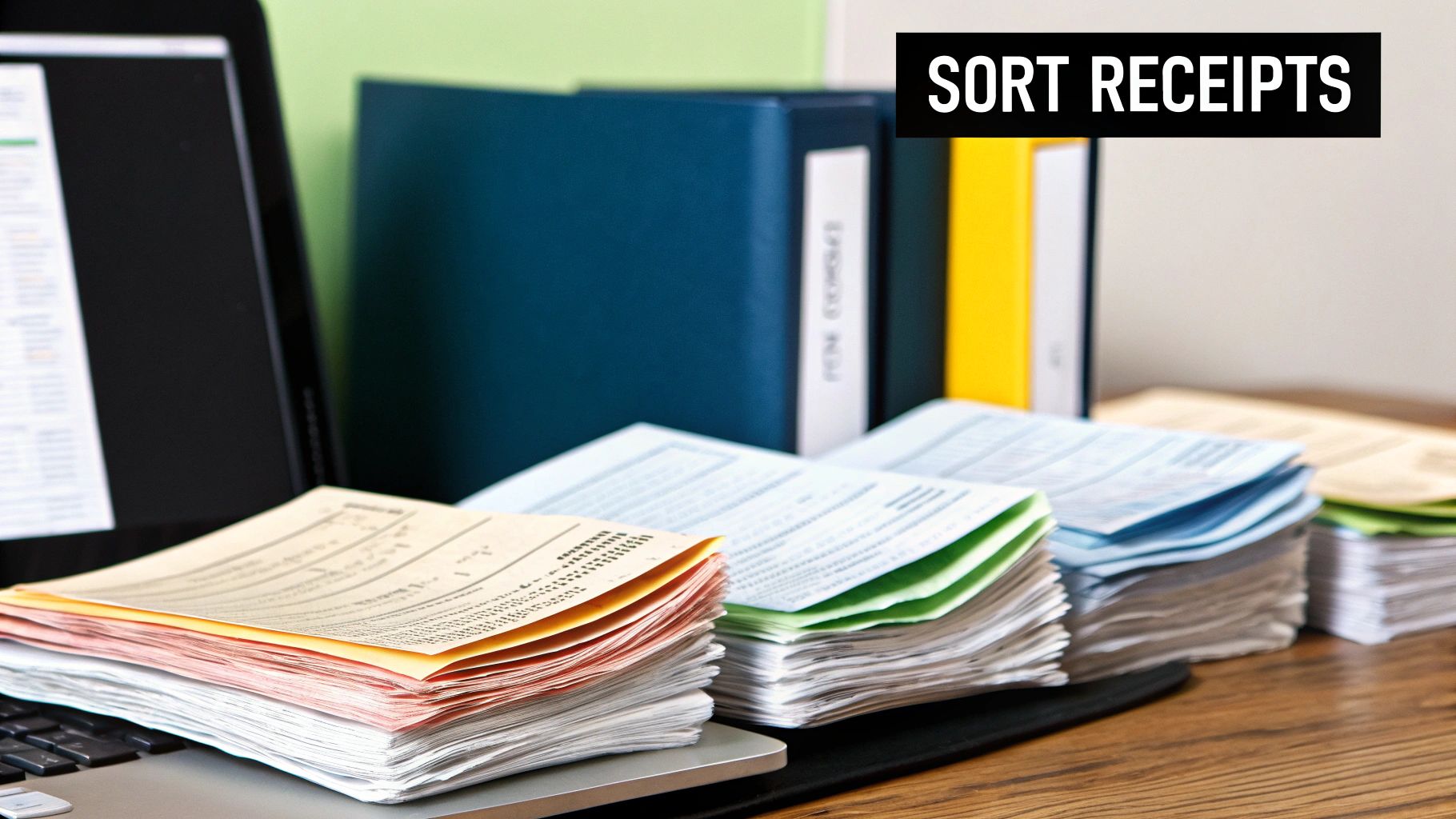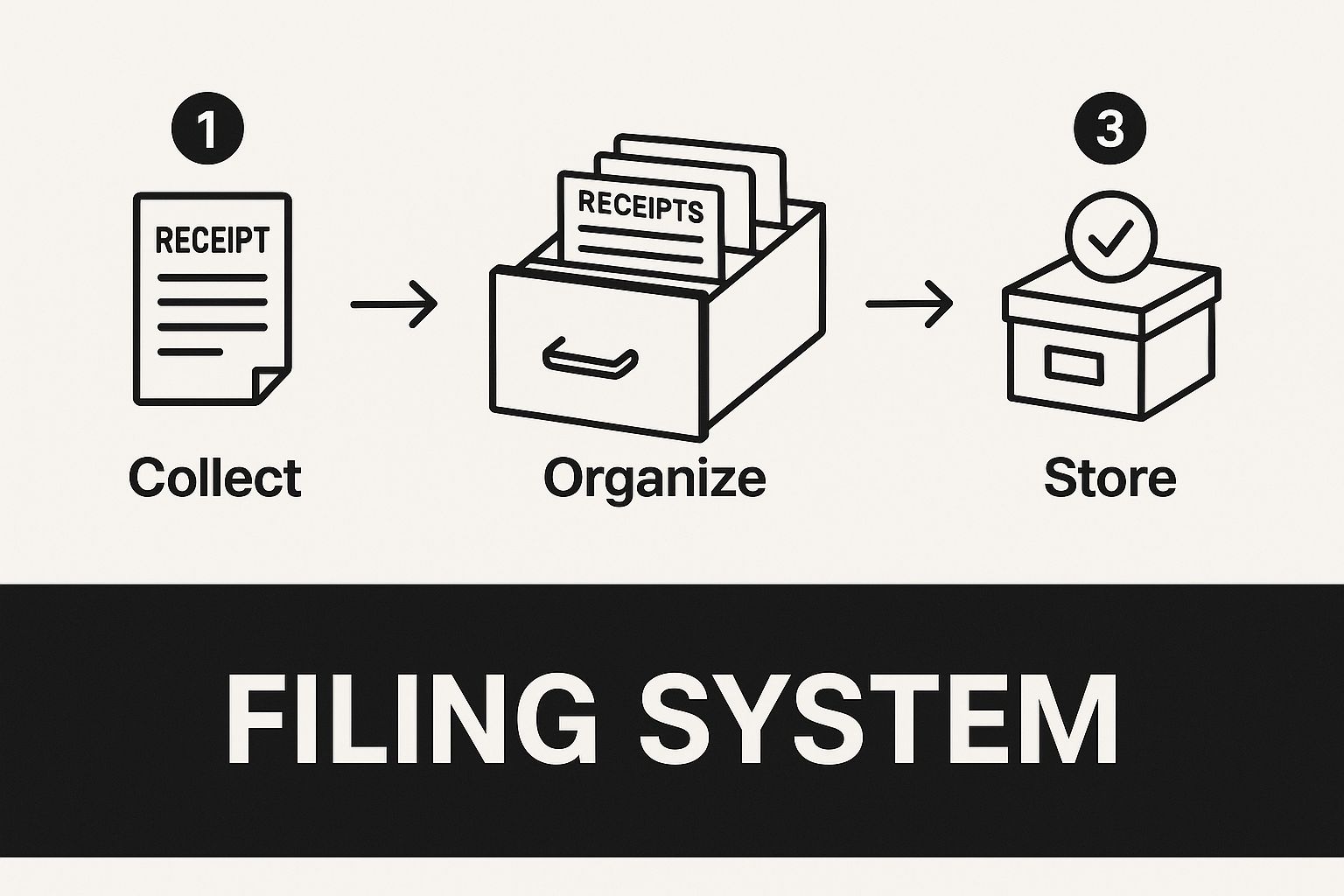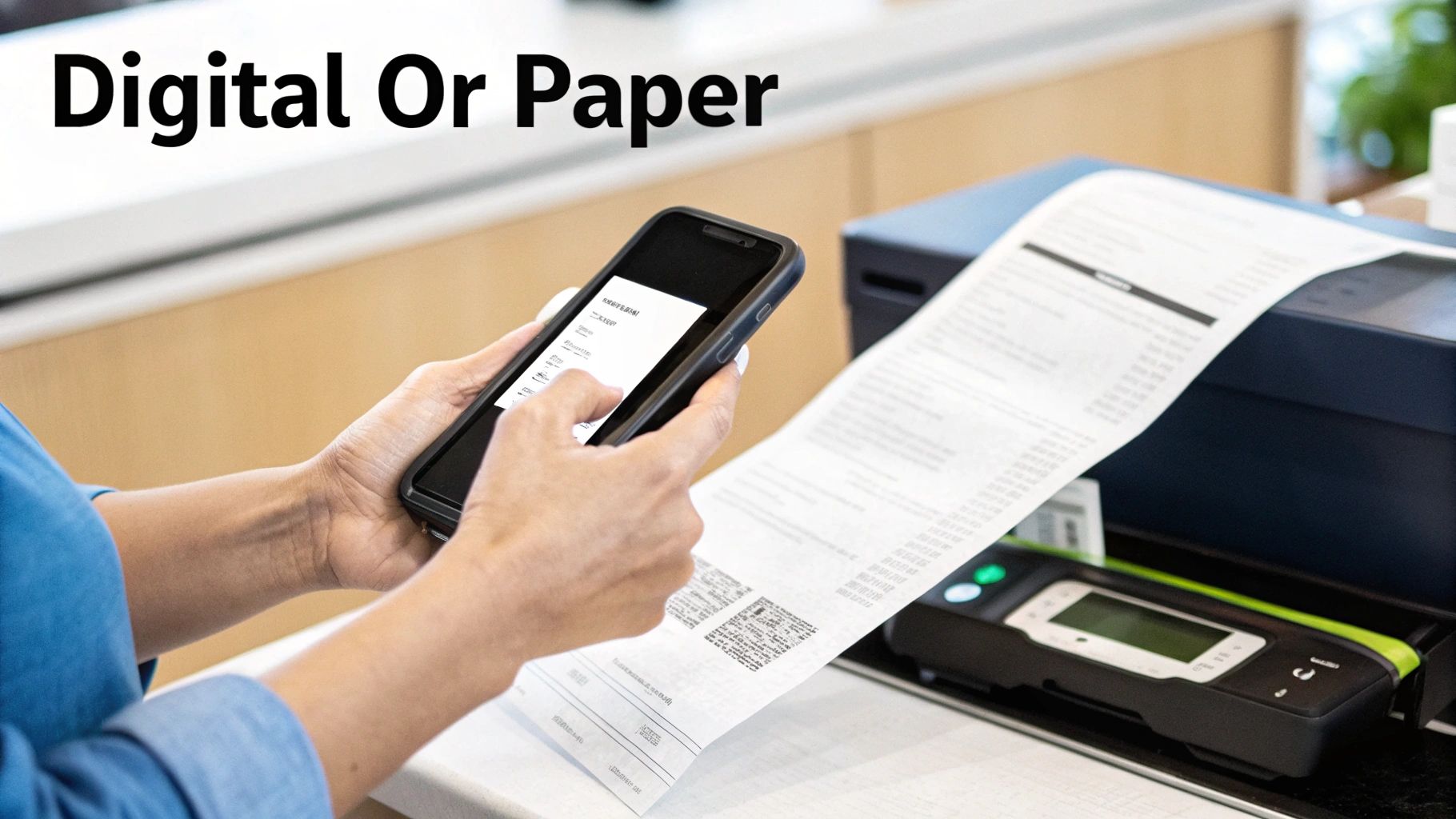How to Organize Receipts for Effortless Tracking
Tired of receipt chaos? Learn how to organize receipts with our guide to digital and paper systems. Finally get your expenses under control for good.
Tags

Finally, a Foolproof Way to Conquer Your Receipt Clutter
Let's be honest: that growing pile of receipts—some stuffed in a drawer, others buried in your inbox—is a source of stress you just don't need. It feels overwhelming, but I promise, getting a handle on it is much easier than you think. Forget about creating some impossibly perfect system overnight. The real goal is to build a simple, sustainable habit that works for you.
We’re going to walk through a straightforward approach that blends the physical and the digital. This isn't just about tidying up; it's about saving yourself a massive headache come tax time and finally getting a clear picture of where your money is going. The small effort you put in now pays off big time down the road.
Why Bother? The Real Cost of a Messy System
Ignoring your receipts isn't just messy; it's expensive. For businesses, the numbers are pretty telling. A study from the Global Business Travel Association found that almost 19% of all expense reports have errors. Think about that. Each one of those mistakes takes, on average, 18 minutes to fix. You can dig into more of these business expense management trends to see the full picture.
Now, translate that to your own life. Whether you're a freelancer or just trying to manage household finances, spending 18 minutes correcting a few receipts quickly snowballs into hours of unpaid, frustrating admin work every single month.
This isn't just about saving a few bucks; it's about reclaiming your time and peace of mind.
Your Quick-Start Receipt Organization Framework
So, where do we start? The key is to stop receipts from ever becoming that dreaded "pile" in the first place. You need an immediate, almost automatic, plan for every single one that comes your way—whether it's a paper slip from the hardware store or an email confirmation from an online purchase.
This table breaks down the core principles into simple, actionable steps for both your paper and digital receipts.
| Core Principle | Paper Receipts Action | Digital Receipts Action |
|---|---|---|
| Create a Central 'Inbox' | Designate one physical spot—a basket, a tray, or an envelope—where ALL paper receipts go immediately. | Create a dedicated email folder (e.g., "Receipts to Process") and forward all digital receipts there instantly. |
| Define Clear Categories | Use categories that match your budget or tax needs, like 'Groceries,' 'Client Lunches,' or 'Software Subscriptions.' | Set up corresponding digital folders or tags in your email or cloud storage to mirror your paper categories. |
| Set a Realistic Schedule | Pick a consistent time to go through your physical inbox—daily, weekly, whatever works for you. Just stick to it. | Block out time on your calendar for a quick digital cleanup. Processing a few receipts is far easier than a massive monthly task. |
Following this simple framework turns a chaotic process into a predictable, manageable routine. It’s the foundation for everything else.
Choosing Your Ideal Receipt Management System

Before we dive into the nitty-gritty of folders and files, let’s talk tools. Getting your receipts organized hinges on finding a system that actually fits your life. If it’s too complicated or rigid, you’ll drop it within a week. The right system can turn a dreaded chore into a simple, satisfying habit.
So, let's walk through the main options, from old-school paper methods to slick modern apps, so you can figure out what’s right for you.
Manual vs. Digital: The Core Decision
First things first: are you a paper person or a digital devotee? There's no wrong answer here. It really boils down to how many receipts you handle, your comfort level with tech, and what you need the records for.
A classic manual system is as simple as it sounds. Think of the envelope method—one for "Groceries," one for "Utilities," one for "Business Lunches." You just pop the paper receipts in the right envelope. It’s tangible, straightforward, and doesn't require any fancy software.
A digital system, on the other hand, means scanning those paper slips and saving everything on your computer or in the cloud. The huge advantage here is searchability. Need to find that hardware store receipt from three months ago? A quick search beats digging through a shoebox any day.
For a lot of people I talk to, a hybrid approach works best. They keep a physical "to-scan" tray on their desk and then digitize everything once a week. It’s a great way to get the best of both worlds.
Getting Real About Your Needs
The perfect system for a freelancer tracking billable expenses is going to look totally different from what a family needs to manage their household budget. Before you download an app or buy a set of file folders, take a minute to ask yourself a few questions:
- •Who are you? Are you a small business owner who needs immaculate records for tax time? Or are you just trying to track personal spending to see where your money goes?
- •What’s your receipt volume? If you have five receipts a week, a simple folder system is probably fine. If you’re juggling dozens, you’ll want to look at automation.
- •What’s the end goal? Is this just for tax season, or do you want to analyze your spending habits and find places to save?
A business owner, for example, needs to prioritize things like detailed categories and the ability to export data to their accounting software. For personal use, a simple, searchable archive might be all you need.
Key Features to Look for in Modern Receipt Apps
If you’re leaning toward a digital or automated solution, you’re in luck. The expense management software world is booming, with an annual growth rate between 8-12%. This competition means better, more powerful, and user-friendly tools are hitting the market all the time. You can see just how fast things are changing by looking at these expense management technology trends.
When you start comparing apps like GetInvoice, here are the game-changing features you should look for:
- •Accurate OCR (Optical Character Recognition): This is the magic that reads the receipt for you. It automatically pulls out the vendor name, date, and total amount, saving you from typing it all in yourself.
- •Cloud Integration: A must-have feature is the ability to sync with services you already use, like Google Drive or Dropbox, or accounting platforms like QuickBooks and Xero. This creates a seamless, connected workflow.
- •Smart Categorization: The best apps learn your habits. They’ll start suggesting categories for your expenses and let you set up rules to automatically tag recurring purchases correctly every single time.
Picking a system with these core features is how you stop managing receipts and start having a system that works for you in the background. It's the key to building an organization method that actually sticks.
Ready to ditch the paper clutter for good? Going digital is hands-down the best way to finally get a handle on your receipts. Let's walk through how to build a digital workflow that takes a receipt from your hand to a secure, searchable file in the cloud. The goal here is to create a simple, repeatable process that quickly becomes second nature.
It all starts with getting a good picture. Your smartphone camera is perfect for this. Just make sure the receipt is on a flat surface with decent lighting, and get the whole thing in the frame. A blurry or cropped photo can trip up even the best software, so a clear shot is key.
Setting Up Your Digital Filing Cabinet
So, you've snapped a picture. Now what? Just tossing it into a single folder on your computer is the digital equivalent of that dreaded shoebox. We need a system. I've found the most effective way is to create folders in a cloud service like Google Drive or Dropbox, starting with the year, then breaking it down by month.
Inside each month's folder, you can create subfolders for your spending categories. It might look something like this:
- •2024
- •01-January
- •Business-Meals
- •Office-Supplies
- •Utilities
- •02-February
- •Business-Meals
- •Software
- •Travel
- •01-January
This simple structure makes finding anything a breeze later on. When it comes to naming the files themselves, consistency is your best friend. I swear by this format: YYYY-MM-DD_Vendor_Amount. For example, a receipt from a coffee meeting becomes 2024-05-21_TheCoffeeShop_12.50.pdf. Simple, searchable, and it tells you everything you need to know at a glance.
This visual really drives home how a little structure can take you from chaos to clarity.

It shows that whether your system is physical or digital, having clear labels is the foundation of staying organized.
The Magic of Automation
This is where you really start to reclaim your time. Sure, you can manually rename and file every single receipt, but that gets old fast. This is exactly why so many of us have turned to specialized apps to do the heavy lifting.
The proof is in the numbers: 75% of businesses now lean on mobile apps for managing their travel and expenses. It’s a massive shift in how we handle this stuff.
A core piece of tech in these tools is Optical Character Recognition (OCR). It’s a game-changer. OCR automatically scans the receipt image and pulls out the key details—vendor, date, and amount—so you don't have to type it all in yourself.
Tools like GetInvoice take it a step further. They can sync with your email and automatically grab digital receipts and invoices as they arrive. No more forwarding or downloading! If you're curious about what's out there, our guide on the best receipt scanning software is a great place to start your research.
For those looking to truly streamline their entire process, exploring workflow automation for small business can unlock even more efficiency, especially when it comes to tracking and categorization. Spending a few minutes setting up these automated rules can genuinely save you hours of tedious work down the road.
A Practical System for Taming Paper Receipts
Let's be real. Even with the best digital tools, paper receipts are a stubborn fact of life. They sneak in from coffee runs, hardware store trips, and client lunches, constantly threatening to turn your desk into a cluttered mess.
The secret isn't to get rid of paper entirely—it's to build a simple physical system that feeds right into your digital workflow. This way, you stop the piles before they even start.
Your first move? Create one, and only one, "inbox" for every piece of paper that comes your way. This could be a simple tray on your desk, a small basket by the door, or a specific pocket in your work bag. The tool itself isn't important; what matters is the habit. Every single time a paper receipt comes into your possession, it goes straight into this inbox. No exceptions.
This simple act of corralling everything in one spot is genuinely the biggest step you can take to conquer paper clutter for good.
Setting Up Your Physical Files
Once you have your inbox, you need a place for those receipts to go after you've scanned and processed them. You don't need a giant, clunky filing cabinet. In my experience, the simplest tools are the most effective.
Here are a few practical options I've seen work well:
- •Accordion Files: These are fantastic because they're portable and have built-in dividers. You can label the tabs with your most common spending categories, like 'Office Supplies,' 'Travel,' or 'Utilities.'
- •Binders with Plastic Sleeves: A sturdy binder gives you a clean, organized home for your receipts. Each clear sleeve can hold all the receipts for a specific category or a particular month. Easy to flip through.
- •Labeled Envelopes: Sometimes, the classics are classic for a reason. Grab a stack of manila envelopes, label them with your categories, and just drop the receipts inside. Simple, cheap, and it works.
Honestly, the best system is the one you’ll actually stick with. Start with whatever feels easiest and most intuitive to you. If it feels too complicated, you'll abandon it within a week.
A question I get all the time is how long to keep the physical paper after scanning it. While a clean digital copy is usually enough, it pays to be a little cautious. The IRS generally suggests keeping tax-related records for at least three years, but some circumstances can require holding onto them even longer.
Knowing the rules helps you avoid turning into a paper hoarder while making sure you're always compliant. At the end of the day, handling physical documents is a core business skill. If you want to go deeper, understanding how to organize paperwork in general can dramatically improve your entire process.
When you blend these physical methods with a smart digital backend, you create a powerful, hybrid system. For those looking to really connect their physical and digital worlds, exploring accounting document management software offers a unified view of all your financial paperwork. It makes finding anything you need, no matter the format, completely effortless.
Building Smart Habits for Long-Term Success

Let's be honest. A great system is only as good as your commitment to it. All the fancy folders and high-tech apps in the world won't help if your receipts still end up in a crumpled mess at the bottom of your bag. The real secret to organizing receipts for good is turning the process into a set of simple, automatic habits.
This isn’t about adding another huge task to your to-do list. It’s about creating small, repeatable actions that slot right into your existing routine, turning a dreaded chore into a satisfying two-minute task.
The Five-Minute Daily Dump
The most powerful habit I’ve adopted is what I call the "daily dump." At the end of each day, I take just five minutes to deal with any new receipts. For paper slips, this means snapping a quick, clear photo with my phone and dropping the physical copy into my "to-be-shredded" bin.
For email receipts from online shopping or subscriptions, I forward them directly to my receipt management app. This simple five-minute ritual prevents the dreaded pile-up and ensures nothing gets lost in the shuffle of a busy week. It’s all about immediate action, not delayed organization.
The goal is to touch each receipt only once. Snap it, send it, and forget it. This micro-habit single-handedly eliminates 90% of the clutter and mental energy previously spent on receipt management.
The Weekly Review and Reconciliation
While the daily dump handles the immediate capture, the weekly review is where you make sure everything is filed correctly. I block out 15-20 minutes every Friday afternoon, but a Sunday evening works just as well. This is your time to quickly go through your digital receipt inbox.
This is your chance to:
- •Confirm categories are correct. Does your software need a little guidance on a new type of expense?
- •Add notes or project tags. This is a lifesaver for business expenses or if you’re tracking costs for something specific, like a home renovation.
- •Handle tricky situations. Did you get one of those ridiculously long register tapes? Check that the digital scan is legible and captures all the key line items you need.
This weekly check-in keeps your system accurate and your financial data clean. Honestly, it’s also incredibly motivating to see your organized folders grow week by week. By integrating these tasks with your existing processes, you can begin to automate bookkeeping and seriously cut down on the manual effort. This consistent rhythm is what transforms receipt management from a chaotic reaction into a proactive, streamlined part of your financial life.
Got Questions About Keeping Receipts? We've Got Answers
Even with the best system, a few questions always seem to trip people up. Taming your receipts can feel like a huge project, so let's tackle some of the most common snags head-on. These are the real-world questions I hear all the time from people trying to get their financial paperwork under control.
How Long Do I Really Need to Keep Receipts for Taxes?
This is the big one, and the answer isn't always cut and dry. For most folks and small businesses in the U.S., the IRS rule of thumb is to keep your receipts and all supporting documents for at least three years after you file your tax return. That three-year window is when they can typically initiate an audit, and it's also your timeframe for filing an amended return if you find a mistake.
But of course, there are exceptions. You'll want to hang onto certain records for longer:
- •Property Records: If you buy a house or a major business asset, keep those receipts for as long as you own the property, plus another three years after you sell it. Think of it as part of the property's "life story."
- •Worthless Securities: Claiming a loss from a bad debt or worthless stock? You’ll need to keep those records for seven years.
The best part? The IRS is perfectly happy with clear, readable digital copies. Once you’ve scanned a receipt and saved it to your secure system, you can usually say goodbye to the paper version and shred it. No more overflowing file cabinets!
What's the Best Way to Deal with All Those Email Receipts?
Ah, the digital clutter. Email receipts are great, but they can overwhelm your inbox in a hurry if you don't have a solid game plan. The trick is to get them out of your main inbox automatically.
Start by creating a dedicated folder or label in your email—I call mine "Receipts to Process." Then, set up a simple filter to catch any email with words like "receipt," "invoice," or "order confirmation" and move it straight into that folder. This one move keeps your primary inbox clean and puts all your digital receipts in one spot.
I make it a habit to clear out this folder once a week. With an app like GetInvoice, you can just forward those emails directly to your account, and it pulls out all the important data for you. If you're doing it manually, just save them as PDFs and upload them to your cloud storage using that naming system we talked about.
Help! I Lost a Business Receipt. What Now?
It happens to the best of us, so don't panic. You still have ways to prove the expense was legit. First, try reaching out to the vendor. Most businesses, especially larger chains, can easily pull up your transaction and send you a copy if you know roughly when you made the purchase.
If that’s a dead end, your next best bet is secondary evidence. A credit card or bank statement showing the transaction is a great start. To really cover your bases, jot down a quick note with the following details:
- •The exact amount paid
- •The date and location of the purchase
- •The business reason for the expense
- •Who you paid (the vendor's name)
While nothing beats the original receipt, this kind of backup documentation is often enough to satisfy an auditor and prove your expense was valid.
Ready to stop wrestling with these questions and just automate the answers? GetInvoice plugs into your email and other business tools to automatically grab, sort, and match up every single receipt and invoice. Ditch the manual entry and get perfectly organized, audit-ready records in a snap. Start your free trial of GetInvoice today!